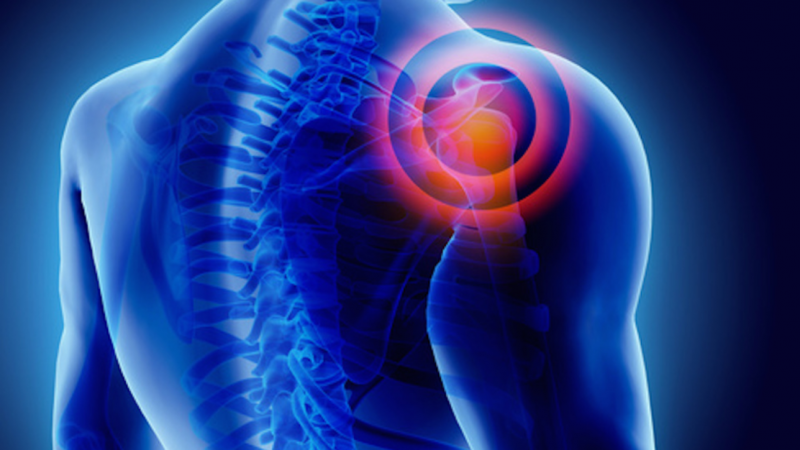Shoulder problems can vary from tendinitis problems to rotator cuff tears.
It is best to consult with a physical therapist due to the complexity of different problems. The shoulder exercises listed in this program are geared to problems of loss of active shoulder motion. Shoulder injuries due from trauma require professional care.
The shoulder is an elegant piece of machinery. It has the greatest range of motion of any joint in the body. However, this large range of motion can lead to joint problems.
The deepest layer of the shoulder includes the bones and the joints. The next layer is made up of the ligaments of the joint capsule. The tendons and the muscles come next.
The important structures of the shoulder can be divided into several categories. These include
- bones and joints
- ligaments and tendons
- muscles
- nerves
- blood vessels
- bursae
The three bones that form the shoulder joint are secured in place by a number of ligaments, as well as the ever important rotator cuff muscles.
The ball and socket structure is the reason the shoulder is one of the most flexible joints in the body. As a result of this freedom, though, the shoulder is the site of many common injuries. Repetitive overhead motions place the muscles and tendons of the shoulder in a vulnerable position. Therefore, many shoulder injuries occur in people with occupations that require overhead work. Most shoulder injuries can be treated conservatively with rest, ice, mobilization, and physical therapy. However, other shoulder injuries require surgical intervention.
Frozen Shoulder: or adhesive capsulitis, is a medical condition that involves progressive pain and loss of motion in the shoulder joint. The exact cause of frozen shoulder is not known, but it is more common in females than males. Frozen shoulder results from a thickening and shortening of the capsule that surrounds the shoulder joint.
Biceps tendonitis: The biceps muscle in a large muscle in the arm that works to bend the elbow as well as elevate the shoulder. This muscle is connected to the bones above and below the arm by a thick strong tendon. Biceps tendonitis results in a painful sensation at the upper shoulder that occurs with movement of the arm
Shoulder Separation: A shoulder separation injury involves a disruption of the acromioclavicular (AC) joint. The most common cause of shoulder separation, or AC joint disruption, is a direct fall onto the shoulder. This fall injures the tendons that provide stability to the joint.
Bicep Tendon Rupture: Rupture of the bicep tendon occurs when the tendon becomes frayed under the shoulder joint. This results when the tendon is placed under friction during repetitive movement of the arm. Symptoms of biceps tendon tears include sudden sharp pain, as well as tenderness to touch in the upper shoulder region.
Impingement: The rotator cuff muscles and tendons surrounding the humerus get pinched between that bone and the scapula.
With pain management and Physical Therapy two-thirds of patients get better on their own.The first step in managing your pain is to ice your shoulder for 15 minutes two or three times a day. As pain starts to subside initiate stretching exercises. Pain should not increase with stretching exercises especially following the exercises. If increased pain apply ice for 10-15 minutes and the next time stretching is applied use less stretching force.
The SHOULDER EXERCISES are divided into two levels.
LEVEL l . Stretching/lengthening exercises: When exercising the shoulders. It is important to regain the motion of the injured shoulder to equal to same as the uninjured shoulder or 80 to 90 % of active motion. Do not start Level 2 strengthening until the motion is close to the range of the uninjured shoulder & pain is subsiding. If the other shoulder motion is limited, a physical therapy referral would be advantageous . Stretching is held 30 seconds , usually 3 to 6 reps. You should not experience increased pain with stretching exercises. Back off and stretch to the edge. Also, you should not get cramping when stretching. Always, stretch opposite shoulder if motion not within normal limits.
LEVEL 2. Strengthening exercises should not increase pain.If the discomfort you may have prior to the exercising is unchanged during the exercising is accepable. However, If increased pain during the exercises, decrease the resistance. If pain continues, go to another exercise. If increased pain remains several hours after the exercises and is unchanged with ice packing discuss it with physician or physical therapist.
Exercise at Level 1 and at level 2 on alternate days. Increase resistance every 5 th session, not increasing resistance more than 10 %. Try to keep each exercise session 12 to 15 minutes. Always, apply ice packing after exercise for 15 minutes. If pain has subsided use ice packing after the strengthening exercises only.



